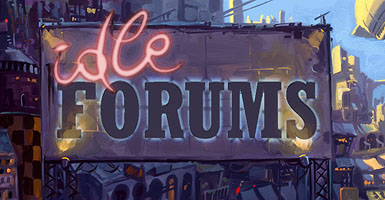-
Content count
7 -
Joined
-
Last visited
About Rich Wilson
-
Rank
Member
- Birthday 01/08/1979
Contact Methods
-
AIM
meathelix
-
Yahoo
meathelix
Profile Information
-
Gender
Male
-
Location
Austin, TX
-
Interests
Game development.
-
Has anybody else played this yet? I saw a single article on RPS a few months ago and grabbed the free download, but since then I've seen very little fanfare over the project. The gist is that you're exploring a tiny star system in your own personal space ship. Full Newtonian physics is in effect, and you can land on the different little odd-ball planets and slowly unravel this story about this alien race. You can walk around inside your little ship, and have to step outside to repair it if you bump into too many things. There's also a cool probe tool that you can launch into space and then hit a button to snap pictures from it. I won't give too much more away, but it's an amazing and confident exercise in non-linear storytelling combined with some cool mechanics that lead to emergent situations. http://outerwilds.com/
-
A friend of mine from 2K Marin has been working on his first indie offering for the past few months, and it looks like he's finally announcing/greenlighting/etc. The game's called Eldritch, and it's a first person roguelike with a Cthulhu mythos vibe, plus stealth and cool mobility (mantling, power slide). Basically Call of Cthulhu: Dark Corners of the Earth meets Spelunky. http://www.eldritchgame.com/ Seems like a good fit for the Idle Thumbs emergent narrative crowd.
-

Idle Thumbs 90: Passive But Deadly
Rich Wilson replied to Sean's topic in Idle Thumbs Episodes & Streams
This episode basically negates my need to drum up a blog post on interaction scale in open world (or any, for that matter) games. It's interesting to look at the spectrum from Miasmata and something like theHunter (From the Just Cause 2 guys. Look it up, it's more awesome than you think.) to Far Cry 3 and then on to Just Cause 2. In Just Cause you can go from walking down a dirt path to hovering at an altitude of 10,000 ft (in a rocket equipped jet craft) in a matter of seconds. In Miasmata, if you try to hop over a dry creek bed, you're likely to trip and drop all of your carefully picked flowers. As an LD, I love to see space mean more in a game, and every square foot has one or more meaning units (MUs) embedded in it. Minecraft is somewhat similar in the material properties of each tile in survival mode, and how you can use those for different purposes, but Miasmata's space impacts your goals (are these the flowers I want?) as well as how you approach those goals (that hill is too steep, I should follow this stream). It has adverbs ingrained in the space in addition to verbs and nouns, I guess. On a different note, I love how they convey goal information in the world. I was pleased that late into the game I was out of leads on certain plants but I was able to formulate a plan instead of just wander aimlessly. The camps are sources of info, this one note mentions a certain camp that was researching the plant I'm interested in, there must be a note there that I missed. Sure enough I went there, scoured the area and found a tent off to the side I'd missed. Also did not see that helicopter battle at the end coming. Who knew it was all set in the distant future? -

Idle Thumbs 89: The Ship Economy
Rich Wilson replied to Jake's topic in Idle Thumbs Episodes & Streams
It might have been more timely in the last episode, but people that want a more "restrained" experience like Far Cry 3 should try out Miasmata. It was made by just two guys and is accordingly rough in spots, but it has some incredible atmospheric gestalt going on when everything lines up right. The short premise is that you're stranded on an abandoned island that once housed some pharmaceutical research facilities. You have to find three components for a cure to this disease you've contracted. The whole thing is fairly HUDless and very immerive with an in world map, a character that animates to interact with everything, physics influenced locomotion model, etc. One of the greatest things is the choice density of the environment. You're constantly searching for plants to pick and analyze. Additionally there's an incredible cartography mechanic required for you to orient yourself on the map, so you're always on the lookout for landmarks. On top of that, locomotion is heavily influenced by physics so you have to be careful about the grade of inclines, location of water, etc. It doesn't have the overlapping systemic emergence that the Far Cry games do so well, but it makes up for it in atmosphere and the way they leave so much investigation, planning and navigation in the hands of the player. -

Idle Thumbs 80: Happy Dishonored Halloween
Rich Wilson replied to Chris's topic in Idle Thumbs Episodes & Streams
Yeah. A lot of that discussion had ossified before I signed on as well. It's a battle between the verisimilitude of satisfying player expectations and the production concerns of handling the fallout from letting the player touch your stuff. I think "guns down" or the bullet proof glass of the Bioshock games is a good way to unask a lot of interactivity questions and the player generally accepts it and moves on. In most cases there will probably be a contingent that disagrees with the way it's handled. Academically and aesthetically I admire and support the attempt to bring narrative elements into the simulation, but you could potentially fall down a rabbit hole trying to cover the contingencies. Branching content based off of key character deaths is practically impossible early in the narrative arc of a AAA content based game, but I think that kind of thing can be handled if you start off structuring your story delivery with that in mind, redundant quest givers, sand box objective structure, procedural story gen (better with text based stuff), "oops all side quests", etc. -

Idle Thumbs 80: Happy Dishonored Halloween
Rich Wilson replied to Chris's topic in Idle Thumbs Episodes & Streams
First, it's cool to hear you guys talking about the Overseer poisoning scene. Also cool that someone experienced the scene from under the table, since that's how I saw it 90% of the time when I was first setting it up. It's rewarding to hear the different approaches to the scene and having it shake out in different ways. You set these things up and send them off into the wild, and there's always this nagging feeling there's something you missed and it's all going to fall apart when it's on a real retail machine. It's interesting to see the discussion spring up around Game Overing the player vs weapons down vs invincible NPCs. I think they're probably all valid in different contexts, and it's mainly a matter of picking which one works for you and then supporting it properly. I personally think that once the player realizes that killing a plot critical NPC ends the game, then it's as effective as a weapons down while maintaining a cohesion between "narrative space" and "gameplay space". This means the player's internal system model can bleed over between the two, and in my mind at least it means that these guys are more "real". They're part of the same simulation where you as the player go around affecting things. We have a lot of plot critical characters out in the mission spaces as well, and "weapons down" isn't feasible when you can lob grenades, summon rats, etc. It is definitely a much contended topic though, and it's been viewed differently at different studios I've worked at. The topic probably deserves more time than I'm cramming into this post, and a lower latency back and forth than a forum can afford. Also, I believe the boatman that takes you to the pub in the first visit tells you all about the two guys you're going to meet inside, so the assumption was that players would know they were friendly. The potential for evesdropping is a cool idea though. -

Idle Thumbs 76: The Three Antidotes
Rich Wilson replied to Sean's topic in Idle Thumbs Episodes & Streams
The reader mail lamenting emergent and imagination-assisted narrative in kids' games was great. Lot of food for thought there, and as a parent I have a similar wish. One game I think that falls into that category was/is The Oregon Trail. I used to play the hell out of that game in 1st and 2nd grade, and it conjured up a ton of horror stories from the American frontier. Writing up epitaphs for travelers you named for friends who died of violence or disease was quite moving (read: often hilarious). FTL also evokes similar feelings to me that I got on an Apple II many years ago.
